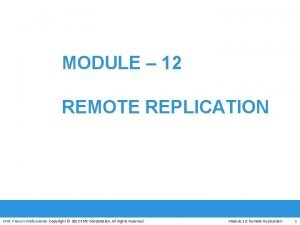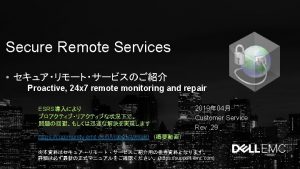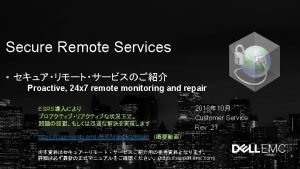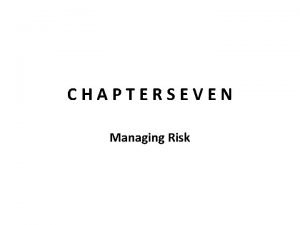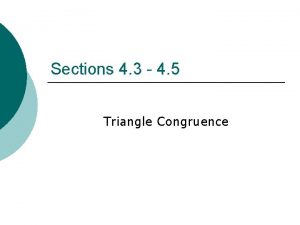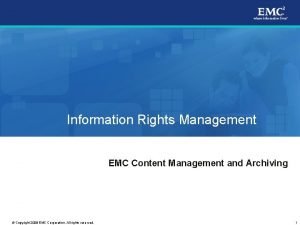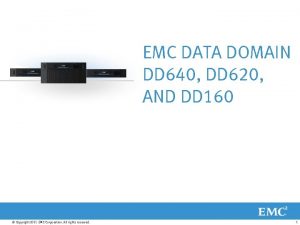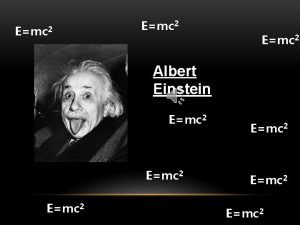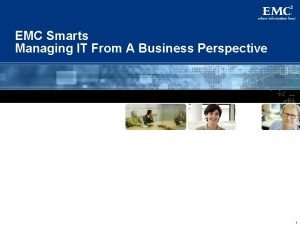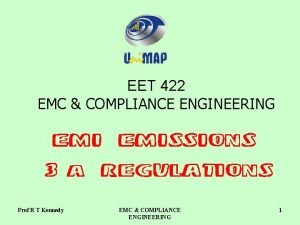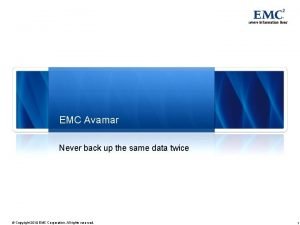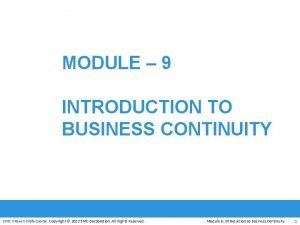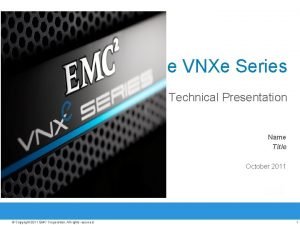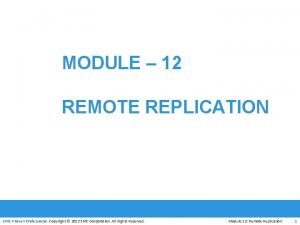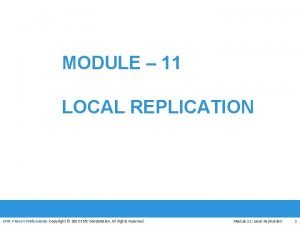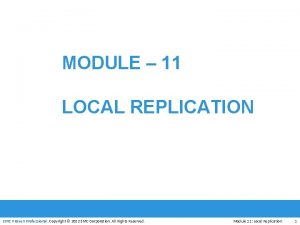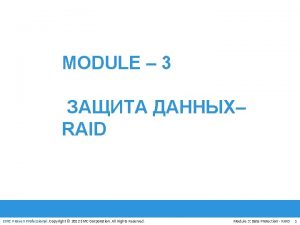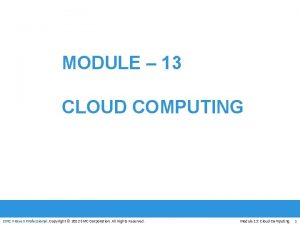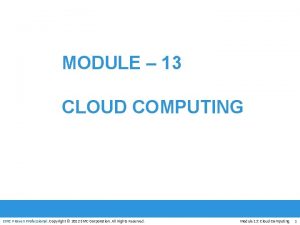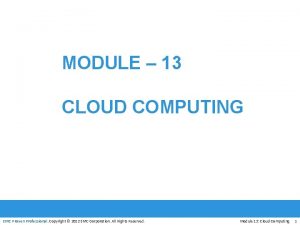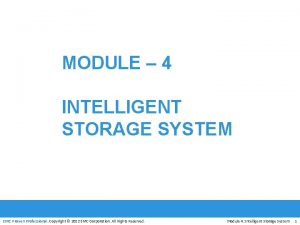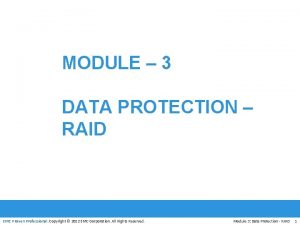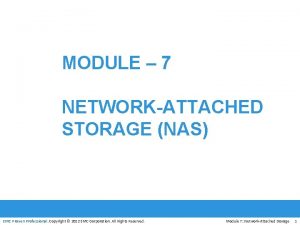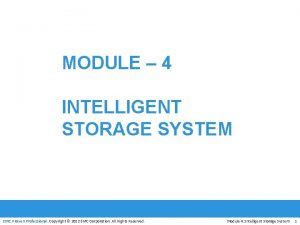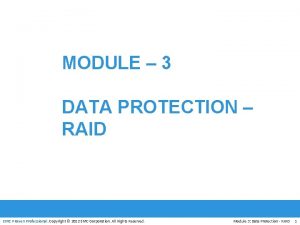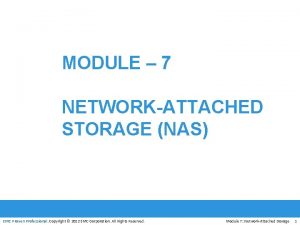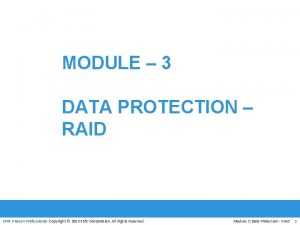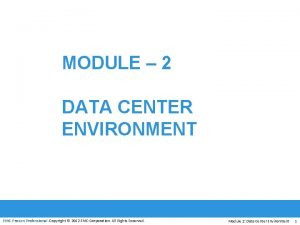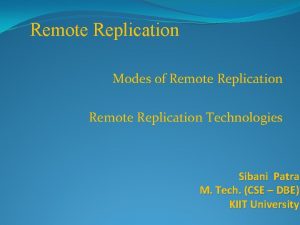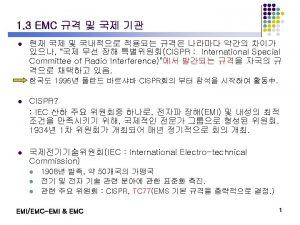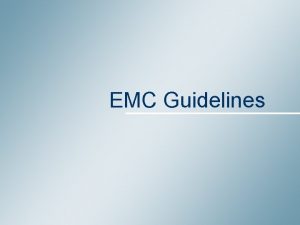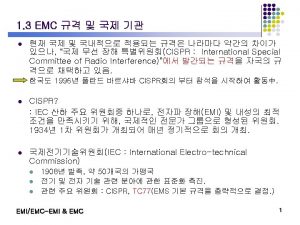MODULE 12 REMOTE REPLICATION EMC Proven Professional Copyright

































- Slides: 33

MODULE – 12 REMOTE REPLICATION EMC Proven Professional. Copyright © 2012 EMC Corporation. All Rights Reserved. Module 12: Remote Replication 1

Module 12: Remote Replication Upon completion of this module, you should be able to: • Explain synchronous and asynchronous replication mode • Describe host-based, array-based, and network-based remote replication technologies • Describe three-site remote replication • Explain data migration solution • Describe remote replication and migration in virtualized environment EMC Proven Professional. Copyright © 2012 EMC Corporation. All Rights Reserved. Module 12: Remote Replication 2

Module 12: Remote Replication Lesson 1: Remote Replication Overview During this lesson the following topics are covered: • Synchronous and asynchronous remote replication • Bandwidth requirement for synchronous and asynchronous remote replication EMC Proven Professional. Copyright © 2012 EMC Corporation. All Rights Reserved. Module 12: Remote Replication 3

What is Remote Replication? • Process of creating replicas at remote sites (locations) 4 Addresses risk associated with regionally driven outages (natural / human-made disasters) • During disasters, the workload can be moved to a remote site to • ensure continuous business operation Modes of remote replication (based on RPO requirement) 4 Synchronous 4 Asynchronous REPLICATION Storage Array – Source site EMC Proven Professional. Copyright © 2012 EMC Corporation. All Rights Reserved. Storage Array – Remote site Module 12: Remote Replication 4

Synchronous Replication – 1 • A write is committed to both source and remote replica before it is acknowledged to the host 4 Synchronous replication write data 1 4 Host 3 to primary storage and the replica simultaneously • Ensures source and replica have • Provides near-zero RPO 2 Target at Remote Site identical data at all times 4 Maintains write ordering Source Data Write Data Acknowledgment (continuous backup) EMC Proven Professional. Copyright © 2012 EMC Corporation. All Rights Reserved. Module 12: Remote Replication 5

Synchronous Replication – 2 • Application response time is • • • increased with synchronous remote replication because writes must be committed on both the source and target Response time depends on bandwidth and distance Requires bandwidth more than the maximum write workload Typically deployed for distance less than 200 km (125 miles) between two sites EMC Proven Professional. Copyright © 2012 EMC Corporation. All Rights Reserved. Required bandwidth Max Typical workload Writes MB/s Time Module 12: Remote Replication 6

Asynchronous Replication – 1 • A write is committed to the source and immediately acknowledged to the host 2 4 Write data to the primary storage first and then copy the data to the replica Source 1 4 Host 3 • Data is buffered at the source and transmitted to the remote site later • Finite RPO (non-zero) Target Data Write Data Acknowledgment 4 Replica will be behind the source by a finite amount EMC Proven Professional. Copyright © 2012 EMC Corporation. All Rights Reserved. Module 12: Remote Replication 7

Asynchronous Replication – 2 • Asynchronous replication • • eliminates the impact to the Typical workload application’s response time Required because the writes are bandwidth Writes MB/s acknowledged immediately to the source host Average RPO depends on size of buffer and available network bandwidth Requires bandwidth equal to or Time greater than average write workload • Sufficient buffer capacity should be provisioned • Can be deployed over long distances EMC Proven Professional. Copyright © 2012 EMC Corporation. All Rights Reserved. Module 12: Remote Replication 8

Module 12: Remote Replication Lesson 2: Remote Replication Technologies During this lesson the following topics are covered: • Host-based, storage array-based, and network-based remote replication technologies • Three-site remote replication • Data migration solution • Remote replication in virtualized environment EMC Proven Professional. Copyright © 2012 EMC Corporation. All Rights Reserved. Module 12: Remote Replication 9

Remote Replication Technologies • Remote replication of data can be handled by host or storage arrays or network-based appliances Host-based Storage Arraybased • Logical Volume Manager (LVM) based replication • Database replication via Log Shipping • Synchronous mode • Asynchronous mode • Disk Buffered replication mode EMC Proven Professional. Copyright © 2012 EMC Corporation. All Rights Reserved. Network-based • Replication occurs at the network layer between the host and storage array

Host-based Remote Replication • Host-based remote replication uses the host resources to • perform and manage the replication operation Replication is performed by host-based software LVM-based replication Log shipping • All writes to the source volume group are replicated to the target volume group by the LVM • Can be synchronous or asynchronous • Commonly used in a database environment • All relevant components of source and target databases are synchronized prior to the start of replication • Transactions to source database are captured in logs and periodically transferred to remote host EMC Proven Professional. Copyright © 2012 EMC Corporation. All Rights Reserved. Module 12: Remote Replication 11

Storage Array-based Remote Replication – 1 • Replication is performed by array-operating environment 4 Better to be used for applications running on the host • 3 replication methods: synchronous, and disk buffered Synchronous Asynchronous Disk-buffered • Writes are committed to both source and replica before it is acknowledged to host • Writes are committed to source and immediately acknowledged to host • Data is buffered at source and transmitted to remote site later • Combination of Local and Remote Replication • A consistent PIT replica is created locally • Then replicated to a remote replica EMC Proven Professional. Copyright © 2012 EMC Corporation. All Rights Reserved. Module 12: Remote Replication 12

Storage Array-based Remote Replication – 2 • Disk-buffered Source Device Local Replica Remote Replica Local Replica Production Host Source Array Target Array Production host writes data to source device. A consistent PIT local replica of the source device is created. Data from local replica is transmitted to the remote replica at target. Optionally a PIT local replica of the remote replica on the target is created. EMC Proven Professional. Copyright © 2012 EMC Corporation. All Rights Reserved. Module 12: Remote Replication 13

Network-based Replication – Continuous Data Protection • Provides any-point-in-time recovery capability during its normal • operation Components of CDP 4 CDP appliance 4 Write splitter 4 Journal volume • CDP appliances are present at both source and remote sites • Supports both synchronous and asynchronous replication modes EMC Proven Professional. Copyright © 2012 EMC Corporation. All Rights Reserved. Module 12: Remote Replication 14

CDP Remote Replication Operation Host Write Splitter Production Volume Source Storage Array SAN Local CDP Applianc e SAN/ WAN Remote CDP Applianc e SAN CDP Journal Replica Remote Storage Array • The replica is synchronized with the source, • One of the copies is sent to the local CDP appliance at the source site, and the other and then the replication process starts. copy is sent to the production volume. • After the replication starts, all the writes • After receiving the write, the appliance at from the host to the source are split into the source site sends it to the appliance at two copies. the remote site. Then, the write is applied to the journal volume at the remote site. EMC Proven Professional. Copyright © 2012 EMC Corporation. All Rights Reserved. Module 12: Remote Replication 15

CDP Remote Replication Operation Asynchronous Synchronous • The local CDP appliance instantly acknowledges a write as soon as it is received • The host application waits for an acknowledgment from the CDP appliance at the remote site before initiating the next write EMC Proven Professional. Copyright © 2012 EMC Corporation. All Rights Reserved. Module 12: Remote Replication 16

Three-site Replication • Data from source site is replicated to two remote sites 4 Replication is synchronous to one of the remote sites and asynchronous or disk buffered to the other remote site • Mitigates the risk in two site replication 4 No DR protection after source or remote site failure • Implemented in two ways: 4 Cascade/multihop 4 Triangle/multitarget EMC Proven Professional. Copyright © 2012 EMC Corporation. All Rights Reserved. Module 12: Remote Replication 17

Three-site Replication: Cascade/Multi-hop • Synchronous + Disk Buffered Source Device Remote Replica Synchronous Disk Buffered Remote Replica Local Replica Source Site Bunker Site Remote Site • Combination of local and remote replication technologies. • Synchronous replication occurs between the source and the bunker • Data is transmitted from the local replica at the bunker to the remote replica at • • the remote site. Minimum of 4 storage volumes are required (including the source) to replicate one storage device. RPO at the remote site is usually in the order of hours for this implementation. EMC Proven Professional. Copyright © 2012 EMC Corporation. All Rights Reserved. Module 12: Remote Replication 18

Three-site Replication: Cascade/Multi-hop • Synchronous + Asynchronous Source Device Remote Replica Synchronous Asynchronous Remote Replica Source Site Bunker Site Remote Site • Synchronous replication occurs between the source and the bunker. • Asynchronous replication occurs between the bunker and the remote site. • The replica in the bunker acts as the source for asynchronous replication to • • create a remote replica at the remote site. RPO at the remote site is usually in the order of minutes. Minimum of 3 storage volumes are required (including the source). EMC Proven Professional. Copyright © 2012 EMC Corporation. All Rights Reserved. Module 12: Remote Replication 19

Three-site Replication: Triangle/Multitarget • Data at source storage Remote Replica array is concurrently s nou o r replicated to two ch Syn different arrays at two Asynchronous with different sites Bunker Site Source Device Differential Resynchronization • The source-to-bunker site (target 1) replication is Asy Source Site nch synchronous with a nearron ous zero RPO. Remote Replica • The source-to-remote site (target 2) replication is asynchronous with an Remote Site The distance between the source RPO in the order of and the remote sites could be minutes. thousands of miles. EMC Proven Professional. Copyright © 2012 EMC Corporation. All Rights Reserved. Module 12: Remote Replication 20

Three-site Replication: Triangle/Multitarget • This implementation does not depend on the bunker site for updating data on the remote site because data is asynchronously copied to the remote site directly from the source. • The key benefit : The ability to failover to either of the two remote sites in the case of source-site failure, with disaster recovery (asynchronous) protection between the bunker and remote sites. • Disaster recovery protection is always available if any one-site failure occurs. EMC Proven Professional. Copyright © 2012 EMC Corporation. All Rights Reserved. Module 12: Remote Replication 21

Data Migration Solution • Specialized replication technique that enables creating remote point-in-time copies. Used for: 4 Data mobility: move data between heterogeneous storage arrays for cost, performance 4 Data migration: move data from one storage array to other heterogeneous storage arrays for technology refresh, consolidation 4 Disaster recovery: Protect your data, minimize downtime & maximize resources 4 Content distribution: provide digital data to geographically distributed end users PUSH Remote Device Control Device PULL Control Array EMC Proven Professional. Copyright © 2012 EMC Corporation. All Rights Reserved. Remote Array Module 12: Remote Replication 22

Data Migration Solution (contd. ) • Moves data between heterogeneous storage arrays 4 Array performing replication operations is called control array 8 Push: Data is pushed from control array to remote array 8 Pull: Data is pulled to the control array from remote array PUSH Remote Device Control Device PULL Control Array EMC Proven Professional. Copyright © 2012 EMC Corporation. All Rights Reserved. Remote Array Module 12: Remote Replication 23

Remote Replication/Migration in Virtualized Environment • Remote mirroring of virtual volume 4 Virtual volumes assigned to hosts are mirrored to two different sites • VM migration 4 Moving VMs from one location to another without powering off VMs 4 Commonly used techniques for VM migration are: 8 Hypervisor-to-hypervisor 8 Array-to-array EMC Proven Professional. Copyright © 2012 EMC Corporation. All Rights Reserved. Module 12: Remote Replication 24

Remote Mirroring of Virtual Volume Data Center 2 Data Center 1 Server I/Os FC SAN Virtual Volume Virtualization Appliance FC or IP Storage Pool Virtualization Layer Storage Array LUN EMC Proven Professional. Copyright © 2012 EMC Corporation. All Rights Reserved. LUN Storage Array Module 12: Remote Replication 25

VM Migration: Hypervisor-to-Hypervisor 2 1 2 2 2 VM Migration Host • Active state of a VM is moved from one hypervisor to another 4 Copies the contents of virtual machine memory from the source hypervisor to the target • This technique requires source and target hypervisor access to the same storage EMC Proven Professional. Copyright © 2012 EMC Corporation. All Rights Reserved. Module 12: Remote Replication 26

VM Migration: Array-to-Array • VM files are moved from source • • 1 array to remote array Can move VMs across dissimilar storage arrays Balances storage utilization by redistributing VMs to different storage arrays 2 Host VM 1 VM Migration VM 1 VM 2 Source Array EMC Proven Professional. Copyright © 2012 EMC Corporation. All Rights Reserved. Remote Array Module 12: Remote Replication 27

VM Migration: Array-to-Array • During replication, there might be a chance that the source is • • updated; therefore, it is necessary to track the changes on the source to maintain data integrity. After the replication is complete, the blocks that have changed since the replication started are replicated to the new location. Array-to-array VM migration improves performance and balances the storage capacity by redistributing virtual disks to different storage devices EMC Proven Professional. Copyright © 2012 EMC Corporation. All Rights Reserved. Module 12: Remote Replication 28

Module 12: Remote Replication Concept in Practice • EMC Symmetrix Remote Data Facility (SRDF) • EMC Mirror. View • EMC Recover. Point EMC Proven Professional. Copyright © 2012 EMC Corporation. All Rights Reserved. Module 12: Remote Replication 29

EMC SRDF • Offers a family of solutions • to implement array-based remote replication Minimizes performance impact on applications and hosts SRDF Family SRDF/S Synchronous for zero data exposure SRDF/Star Multi-site replication option SRDF/CE Cluster Enabler option SRDF/AR SRDF/A Automated Replication option Asynchronous for extended distances Consistency Groups SRDF/DM Cascaded SRDF and SRDF/EDP Efficient Symmetrix-to. Symmetrix data mobility SRDF/CG Extended Distance Protection Concurrent SRDF Concurrent Replication EMC Proven Professional. Copyright © 2012 EMC Corporation. All Rights Reserved. Module 12: Remote Replication 30

EMC Mirror. View • Replicates data from a primary volume to a secondary volume • that reside on different VNX storage systems Uses a bitmap to track host writes while the link to the secondary array is down 4 When secondary is available, sends only changed data • Mirror. View family consists of: 4 Mirror. View/Synchronous (Mirror. View/S) 4 Mirror. View/Asynchronous (Mirror. View/A) EMC Proven Professional. Copyright © 2012 EMC Corporation. All Rights Reserved. Module 12: Remote Replication 31

EMC Recover. Point • Recover. Point Continuous Remote Replication (CRR) provides • both synchronous and asynchronous remote replication Dynamically switches between synchronous and asynchronous replication 4 Based on the policy for performance and latency • Capable to recover data remotely to any PIT EMC Proven Professional. Copyright © 2012 EMC Corporation. All Rights Reserved. Module 12: Remote Replication 32

Module 12: Summary Key points covered in this module: • Synchronous and asynchronous replication mode • Host-based, array-based, and network-based remote replication • Three-site remote replication • Data migration solution • Remote replication and migration in virtualized environment EMC Proven Professional. Copyright © 2012 EMC Corporation. All Rights Reserved. Module 12: Remote Replication 33
 Emc proven professional
Emc proven professional Bioflix activity dna replication lagging strand synthesis
Bioflix activity dna replication lagging strand synthesis Dell secure connect gateway
Dell secure connect gateway Policy manager for secure connect gateway
Policy manager for secure connect gateway Proven healthcare solutions
Proven healthcare solutions Proven amazon course for $99
Proven amazon course for $99 Wisdom is proved right by all her children
Wisdom is proved right by all her children Proven in use
Proven in use Risk response
Risk response 3 4 5 triangle
3 4 5 triangle C device module module 1
C device module module 1 Emc
Emc Vivre ensemble cycle 1
Vivre ensemble cycle 1 Emc content management
Emc content management Data domain dd160
Data domain dd160 How did albert einstein die
How did albert einstein die Emc smarts global console
Emc smarts global console Emc vlab
Emc vlab Emc en seconde
Emc en seconde Pechhulp emc
Pechhulp emc Flash to unity converter
Flash to unity converter Dell fc640
Dell fc640 Vmware latf
Vmware latf Emc disaster recovery
Emc disaster recovery Avamar ndmp
Avamar ndmp Storage area networks tutorial
Storage area networks tutorial Module 12 - introduction to business continuity
Module 12 - introduction to business continuity Emc virtual storage integrator
Emc virtual storage integrator Common mode signal
Common mode signal Emc brs
Emc brs Albert einstein emc
Albert einstein emc Wat eet een zeevarken
Wat eet een zeevarken Iec 62132-4
Iec 62132-4 Emc vnxe 3100 manual
Emc vnxe 3100 manual
